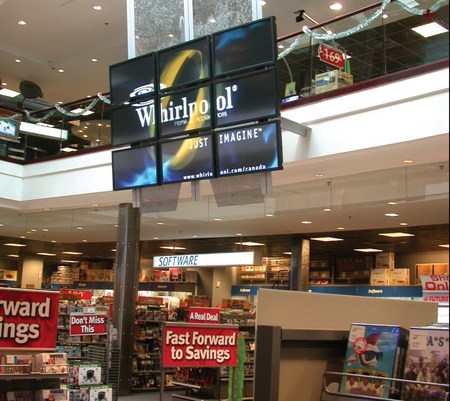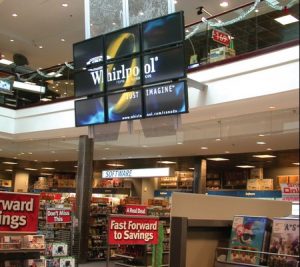According to Stuart Kirkpatrick, president of Digital Display & Communication Ltd. (DDC), Waterloo, Ontario, Canada, the company has specialized in electronic digital signage (EDS) since 1996. In its embryonic era, the company distributed the technology and, approximately eight years ago, became a complete system integrator, network operator and content developer. In the interim, Kirkpatrick has noted the technology’s evolution.
“In the early days, the technology involved simply created continuous loops of graphic files shown on cathode-ray screens in electronics stores,” he said. “Now, we have banks, corporate campuses, colleges, car dealerships and various other venues that see the benefits of the technology to educate, direct and entertain viewers. And, the evolution of LED, plasma and LCD flat-panel displays has made the technology much more visually appealing and effective.”
When addressing a client’s needs, the realtors’ cliché — “location, location, location” — applies. LED readerboards typically suit outdoor installations, whereas flatscreens are usually preferable for indoor applications.
However, if an indoor site requires an especially large display, Kirkpatrick may bundle LCD panels, large-format, digital-light processor (DLP) rear-projection or LED screens. Though he says it’s not sufficiently used in the conventional wayfinding context, EDS can provide information that helps acclimate viewers to available amenities, products and services. And, he said clients benefit from taking a broad perspective when considering system content.
“I think the first impulse is to create an ad-based content program, but this can present challenges,” Kirkpatrick said. “This creates competition with TV, newspapers and billboards, and sometimes third-party advertisers are reluctant to go along. A relevant, entertaining and targeted body of content will generate more attention.”
Advertisement
He said Future Shop, a Canadian electronics store, exemplifies the EDS revolution. When the company first partnered with DDC to develop an EDS network in 1996, the work entailed simple distribution of broadcasting static advertising messages and product information. In 2001, DDC converted Future Shop’s program to high-definition (HD) content.
Since then, the company has installed 9 x 16-ft., rear-projection screens that display content that varies from promoting store creditcard sales to video feeds of forthcoming DVD releases that provide eye-catching HD content.
While some chains were early EDS adopters, others are just catching up. Moreover, EDS agendas vary widely. Kirkpatrick says this diversity creates the challenges system integrators face in the next generation.
“There’s a lot of fragmentation,” he said. “This is much more complicated than someone buying a fourth car, when they know what they need and expect. There are hardware companies, software companies, integrators, content providers – a lot for a first-time buyer to understand. Clients must understand their customers’ needs and traffic patterns, and engineer, and budget for, content accordingly.”
In addressing EDS’ wayfinding potential, Kirkpatrick said a client has to perceive that it fulfills an immediate need through providing specific services, such as ATMs and airport check-in kiosks. He acknowledges tremendous need for EDS as directional cues in hospitals and public spaces, but that governing authorities have been slow to adopt them.


 Tip Sheet1 week ago
Tip Sheet1 week ago
 Photo Gallery3 days ago
Photo Gallery3 days ago
 Ask Signs of the Times5 days ago
Ask Signs of the Times5 days ago
 Real Deal2 weeks ago
Real Deal2 weeks ago
 Benchmarks1 week ago
Benchmarks1 week ago
 Paula Fargo10 hours ago
Paula Fargo10 hours ago
 Photo Gallery10 hours ago
Photo Gallery10 hours ago
 Women in Signs2 weeks ago
Women in Signs2 weeks ago













